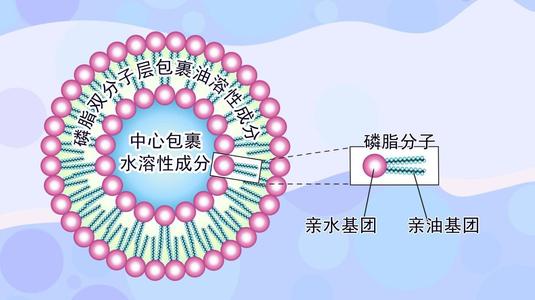Research progress of liposome and encapsulation technology in cosmetics
Source: web name Publication Date:2019-10-17 Attention:
The future of liposome technology
Liposome can not only effectively disperse cosmetic ingredients, but also is a good excipient for compatibility with phosphatidylcholine. The dermatological agents made by liposome technology have been successfully used to treat several kinds of skin diseases. Generally speaking, liposomes and nano emulsions are better suited for skin texture than those used in nanoemulsion. In other words, this kind of formula will not destroy the overall structure of double skin fat layer, and will not be washed out when cleaning the skin. In the sense of modern cosmetics development strategy, this kind of prescription contains the lowest excipient ingredients, which only brings little burden to the skin. It is worth noting that phosphatidylcholine has been proved to be stable at low concentrations, so it is not necessary to make a high concentration formula. Moreover, repeated application of phosphatidylcholine in the cuticle will also produce accumulation effect. In most cases, liposomes and nanoemulsions are compatible with each other and can be used as an architectural tool.

Although nanoparticles are more and more used in cosmetics, and the amount of patent authorization is also increasing, there are few publications and research reports related to the external use of nanoparticles in skin. The combination of active ingredients and nanospheres attempts to regulate the release rate of active ingredients on the skin. When considering the preparation of nanocapsules, the active components are usually lipophilic, and they can also be composed of oily compounds or dispersions. Its aim is to control its release rate by protecting the active ingredients. The release rate of active components depends on their own properties. Lancome has launched a cosmetic containing vitamin E nanocapsules (Primordiale). The company claims vitamin E can be widely distributed in a concentration gradient through the outer layer of the skin. It has been proved that vitamin E can not only protect its efficacy, but also improve its stability. This kind of ultra-fine particle also has stickiness, which can form a layer of sticky film on the skin surface to achieve the moisturizing effect. The hydration of the skin can also accelerate the penetration of active ingredients through the skin and improve the skin care effect. The idea that nanoparticles (polyamides) adhere to the skin surface to extend the release time has been proved to be feasible. When the encapsulated particles in emulsion increased from 40% to 98%, the release time prolonged. Particle size, surface charge and payload determine the properties and applications of nanoparticles. The researchers encapsulated uvinil t 150, a UVB filter, into lipid nanoparticles. They found that uvinil t 150 had 100 times more affinity to hair than to hair. They also found that gels containing vitamin A and E nanoparticles were more effective than blank controls.
Microemulsion
Over the past more than 10 years, researchers have extensively studied the transdermal absorption properties of active components in microemulsions. Nowadays, a large number of cosmetics are in the form of microemulsion, including body care products, facial care products and hair care products. Among them, bath oil, slimming products, hair styling agents, hard nail oil, moisturizers, anti wrinkle agents, anti seborrhea products and anti-aging products are mainly sold in Europe, the United States and Japan and other markets.
Some scholars have designed in vitro experiments to simulate the permeation of microemulsion through skin. The O / W microemulsion of tyrosine is composed of betaine derivative surfactant, benzyl alcohol, cetane and water. A diffusion cell test device with rat skin as filter screen was used to compare the release of tyrosine from the microemulsion carrier with that from the liquid crystal system and emulsion. The results showed that both the microemulsion and the liquid crystal formulation were higher than those of the emulsion through tyrosine penetration. However, the skin irritation test showed that the liquid crystal formula had strong skin irritation, and microemulsion had no skin irritation.
Microemulsion often has a skin irritant response due to its high content of surfactants. This kind of problem can be found in microemulsion prepared by non-ionic and polymer surfactants with physiological affinity. The possibility of irritation of microemulsion formula is closely related to its results. Due to the balance between microemulsion and liquid crystal, when microemulsion contacts the skin, it may dissolve the skin, resulting in reorganization into liquid crystal form. So skin irritation started to appear. Based on this, the properties of the system formed in the transdermal process and the surfactants remaining on the skin surface are very important to prevent skin irritation. Human skin acute irritation test and cumulative stimulus test were completed by using phospholipid microemulsion gel, single layer soybean phospholipid liposome and isopropyl palmitate. The results showed that the acute irritation of soybean lecithin microemulsion gel was very low and the storage stimulus was low. In general, the microemulsion structure changes due to the penetration and / or evaporation of the ingredients and the water intake of the skin after the microemulsion is applied to the skin. The formation of substances and their transdermal behavior will ultimately affect the effectiveness of the drug delivery system in the skin.
The future development of encapsulation technology
It's not easy to predict what benefits we'll get from encapsulation in the future. When it comes to the future development of encapsulation technology, we should have a clear understanding that application-oriented research focuses on solving practical problems. If the number of published papers on encapsulation technology (including liposomes, nanoparticles, microparticles, microemulsions, composite emulsions and nanoemulsions) indicates an important indicator of the development of this knowledge field, then there will be greater development in this field in the next few decades.
